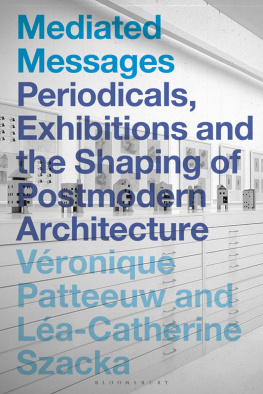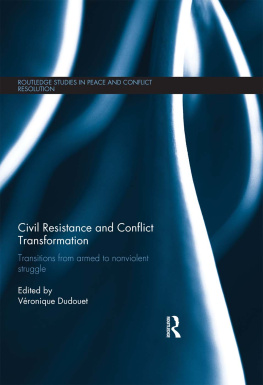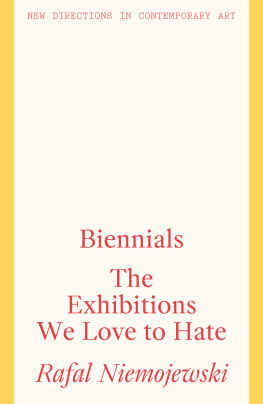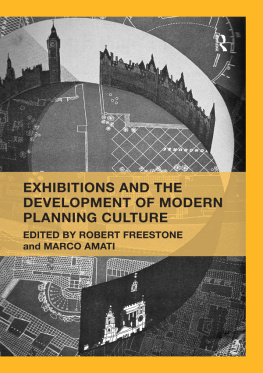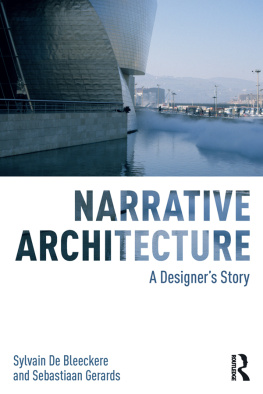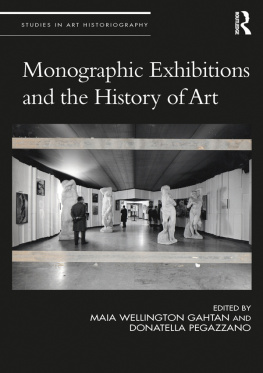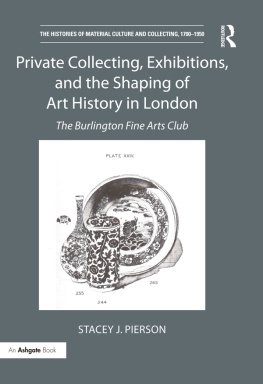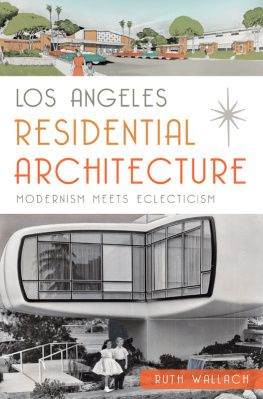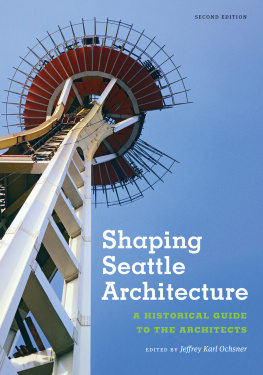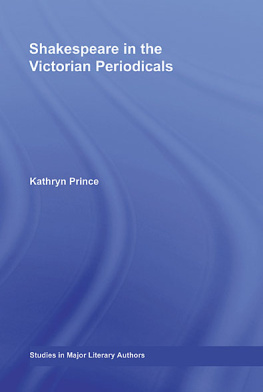MEDIATED MESSAGES
MEDIATED MESSAGES
Periodicals, Exhibitions and the Shaping
of Postmodern Architecture
Edited by
Vronique Patteeuw and
La-Catherine Szacka

BARRY BERGDOLL
P ostmodernism, it might be claimed, was issued onto the world stage in 1980 through the cinema sets created in response to Paolo Portoghesis casting call for the Venice Biennales first full-fledged extravaganza of architectural display. Or, at the very least, that was the ambition of an event that capitalized on the shifting of attitudes that was long underway in many quarters. If, nearly six decades earlier, the black-and-white photographs of the Museum of Modern Arts (MoMAs) 1932 show Modern Architecture: International Exhibition had also doubled as images circulated to the professional press which aimed at sponsoring a shift in the taste culture of American architecture, now the images coming from Venice were full-blown technicolour, as apt to appear in lifestyle magazines as in the professional press, ready for the evening news on television, and participating in a media world that had expanded exponentially in the post-war decades. MoMA showed images of buildings already extant around the world (international it was claimed, when in fact they were culled from but two continents), whereas in 1980 the images and what they depicted came into existence simultaneously in Venice. 1980s images, moreover, were images of images, marking them in that regard as much a part of emergent postmodernism as they were by virtue of their revelling in historical imagery, ironic multiple coding, or their embrace of artifice.
Exhibitions and the periodical press, as time-bound and ephemeral media, had always had a symbiotic relationship; but it was one that grew dramatically with the advances in the closing years of the nineteenth century of the ability to reproduce photographs inexpensively as an integral part of a printed newspaper or magazine. Curatorial and editorial choices began to work in tandem. At its founding in 1932, the New York museums Department of Architecture was primarily a clearing house of photographic images hoping to change the visual landscape of both the professional magazines that US architects followed and the daily newspapers. The department did not collect or for that matter display architectural drawings, but rather photographs that could be frequently reproduced for travelling displays or by being loaned out to the press. Reproducibility rather than originality was the ethos that distinguished MoMAs novel Departments of Architecture and of Industrial Design from that of Painting and Sculpture.
Postmodernism was not the first international movement in architecture to leverage the power of the intertwined media of exhibitions and periodicals; but it was, arguably, the first to realize that it might be possible for architecture to exist exclusively in that world. Philip Johnson and Henry-Russell Hitchcock, co-curators of the 1932 show, insisted that their exhibition feature only built work, lest what they baptized as The International Style be dismissed as merely a world of chimeric projections, of avant-garde postures confined to the circuits of the art world. Images were gathered of work that had been created in the previous decade, at once retrospective and prognostic. What Jean-Franois Lyotard had labelled The Post-Modern Condition in 1979 was characterized by a permanent blurring, negation, indeed, of any distinction between reality and publicity. The Strada Novissima that Portoghesi orchestrated in the Corderie of the Venice naval arsenal was emphatically a stage set and was born famous, although its critical reception was based largely on photographs that circulated widely and long after the display had been dismantled. Postmodernisms arsenal would be media tools, its existence based on a media ecology in which the symbiosis between institutions of display and institutions of publication, of publicity tout court, was primary. If it is still possible to visit many of the key works cited in the 1932 publication The International Style, most of the key works of early postmodernism exist only in the pages of periodicals where they circulated for years. The Strada Novissima enjoyed a brief recreation in Paris in 1981, but few whose attitudes about architecture were influenced by it had experienced it directly. In this it was anticipated by only a few key buildings of early international expositions, such as Mies van der Rohes 1929 Barcelona Pavilion, known only through black-and-white photographs until it was recreated in full-blown colour in the 1980s at the height of postmodernism.
While Beatriz Colomina in Privacy and Publicity: Modern Architecture as Mass Media (1994)example. It was an example that was to be emulated rapidly on both sides of the Atlantic, notably at Columbia University once Bernard Tschumi moved there from the AA to take up the deanship in the late 1980s. At the same time as architecture gained a foothold in the Venice Biennale, an established bulwark of the art world since the 1890s, the periodical press began to pay more and more attention to the exploding world of exhibitions as much as the world of completed buildings. Magazines in which postmodern imagery and reflections circulated were often established magazines garnered to the cause: Domus, Architectural Design, Yale Universitys Perspecta, Archithese, all analysed here in a series of case studies that offer so many facets of a world of increasingly international networks.
Architecture history has caught up with postmodernism in architecture, it might be said, with the institutional turn in the study objects of the discipline. In the last decade architecture historians have enriched our understanding of architecture culture, particularly of modernity, as they have moved away from the primacy of the traditional monographic celebration of the individual creator or from the study of patrons, clients, and building types that accompanied the rise of a social history of architecture in the 1960s, to name but a few of the enrichments of the arsenal of analysis that has accompanied scholarship. Rather, the role media from print to the growing world of what Lyotard called the immaterial has played in not only the reception but the production of architecture has increasingly been a concern. The press, museums, spaces of exhibition, and the media in general, have been understood as institutions in their own right, as much as institutions of government. The editors of this volume are themselves key contributors to that growing trend, La-Catherine Szacka in her important study of the 1980 Venice Architecture Biennale and Vronique Patteeuw with her recent PhD on French architecture periodicals of the 1960s. Assembled in this volume are invaluable case studies of some of the periodicals that contributed to the trend as well as to some of the institutions, notably the MoMA, who responded and, to some extent, contributed to a complex emergence of an interlocked network of agents of image production and circulation. But equally important is the paradoxical weakening of the traditional hierarchy of institutions: institutions that rode on an accepted hegemony, like MoMA, were often displaced by other more innovative producers from Londons Architectural Association to New Yorks Institute of Architecture and Urban Studies, which, under Peter Eisenman, realized that the nexus of exhibitions and publications, particularly when emanating from the same institution, could have a multiplier effect throughout the profession and beyond. By the early 1980s it had developed a sophisticated hierarchy of publications from the book-like journal
Next page
